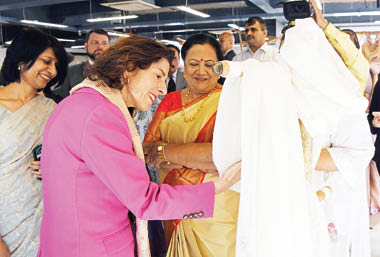India is spinning an ambitious yarn of textiles growth inspired by the 5F vision of Prime Minister Narendra Modi—farm to fibre to factory to fashion to foreign—which will be shaped by textile parks with world-class industrial infrastructure to attract cutting edge technology, global players to manufacture in India, higher FDI, local investment in the sector and generate 20 lakh jobs. Despite adverse headwinds, the Government is convinced of India’s potential to occupy a place in resilient supply chains and has set a target of USD 100 billion textile exports from India in the next five years. President of the Federation of Indian Exporters Organisation, A. Sakthivel, underlines India’s advantage in the textile sector with abundance of natural fibres, skilled manpower and competitive wages. “Besides, we are in the entire value chain of textile from fibre-yarn-fabrics-made ups and garments,” says Sakthivel.
On a more positive note, amidst a global slowdown, the operating profitability of cotton yarn spinners is set to improve to 11-12 per cent in fiscal 2024, says Crisil Ratings despite muted exports, the setting up of a PM Mega Integrated Textile Sector and Apparel (PM MITRA) textiles park in Uttar Pradesh’s Lucknow and Hardoi districts has been approved and an agreement has been inked to establish the first mega integrated PM Mitra Park in Tamil Nadu. On the exports front, India scaled its highest exports tally at USD 44.4 billion in textiles and apparel (T&A) including handicrafts in FY 2021-22, indicating a substantial increase of 41% and 26% over corresponding figures in FY 2020-21 and FY 2019-20, respectively. India’s top textile destination, the USA, accounts for 27% share, followed by EU with a share of 18%, Bangladesh with 12% and the UAE with 6%.
Global headwinds have since taken the shine off textile exports, suggests a Bank of Baroda review of India’s external sector in FY23. In FY23, while India’s merchandise exports rose by 6% to USD 447.5 bn from USD 422 billion in FY22, within this, exports of textiles dropped the most by 13.6% amidst a fall in global demand. Other reports suggest domestic production has turned sluggish in recent months, exports are facing stiff competition from countries like Bangladesh and Vietnam due to preferential tariff treatment and from cheap Chinese imports.
All this has prompted an aggressive campaign to diversify the textile industry output by boosting the technical textile sector which rides on the Rs 1,480 crore National Technical Textile Mission. Though India has a global market share of about 2.5 in technical textiles, the Government believes the domestic market can grow faster than 12% with a conscious plan to showcase its purposes, as visible in the outcome of the recent FICCI Technotex’23 which attracted more than 150 exhibitors and more than 250 buyers from more than 30 countries. Commerce and Industry Minister Piyush Goyal reckons the technical textile industry should be USD 100-125 billion strong by 2047 and can aim for USD 200 billion, in sync with the continued expansion of the global technical textile industry as well growth in domestic consumption and export. Stepping up efforts to tap the vast range of usage for technical textiles, the Government has asked startups and large corporations to consider expanding rapidly in the technical textiles field by exploring what new compounds, fabrics, composites and final products can be leveraged to capture the global market. According to Rajeev Saxena, Joint Secretary, Ministry of Textiles, amongst the 12 segments in technical textile, industrial textiles and medical textile have the largest market share with additionally, agrotech, building textiles and geotextile offering significant impact in strengthening the technical textile sector.
Rapid progress in the infrastructure sector, especially in the PM Gati Shakti Scheme is creating a demand for geo-textile which is a geo-synthetic fabric used in construction projects, road and railway embankments, earth dikes and coastal protection structures.
In another major step towards making India a global hub for textile manufacturing and exports, the Government is setting up seven Integrated Textile Regions and Apparel (PM MITRA) Parks in Tamil Nadu, Telangana, Gujarat, Karnataka, Madhya Pradesh, Uttar Pradesh Maharashtra. “This is the Government’s “effort to bring consolidation in the industry,” Commerce and Industry Minister Piyush Goyal had told the Sunday Guardian after the announcement of the locations in March 2023. “The scale helps you become more competitive both in India and internationally,” Goyal said. The seven PM MITRA parks will come up with a cost of Rs 4,045 crore and envisages investment of nearly Rs 70,000 crore, offering an opportunity to create an integrated textiles value chain right from spinning, weaving, processing/dyeing and printing to garment manufacturing at a single location.
A lot is also rising on the Production Linked Incentive (PLI) Scheme to promote production of MMF apparel, MMF fabrics and products of technical textiles in the country and enable the textiles Industry to achieve size and scale to become competitive. The scheme has generated a good amount of interest and is expected to bring in an estimated roughly Rs 10,000 crore in the technical textiles sector, according to Rachna Shah, Secretary, Ministry of Textiles. Of a total of 67 applications received so far, the Textile Ministry has selected 64 applicants. Investment to the tune of Rs 1536 crore approximately has been made by 56 applicants who have completed the mandatory criteria for formation of a new company and been issued approval letters.
There is an opinion in industry that while the PLI for the apparel sector is helpful in reducing dependency on imported fabrics and increasing investment and employment, the requirement of minimum investment of Rs 100 crore-300 crore was very high. India’s readymade garment exports may see a compounded annual growth rate of 12-13% and surpass $30 billion by 2027, as per industry sources, but Chairman of Apparel Export Promotion Council Naren Goenka says capacity development in the apparel sector is the need of the hour.
Technical textiles, PM MITRA parks key to India’s $100bn textiles export target
- Advertisement -

